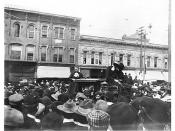In the United States, prohibition became so popular in the early 1900's that, in 1920, a prohibition amendment was added to the U.S. Constitution. This amendment, the 18th Amendment, caused the use of alcoholic beverages to decline sharply. However, many people ignored the national ban and drank illegal beverages supplied by networks of bootleggers. The 18th Amendment was abolished in 1933. It is the only amendment to the U.S. Constitution that has ever been repealed. Canada, Finland, and Norway also outlawed intoxicating beverages during the early 1900's.
In the 1600's and 1700's, the American colonists drank large quantities of beer, rum, wine, and hard cider. Such alcoholic beverages were often safer to drink than impure water or unpasteurized milk and were less expensive than coffee or tea. By the 1820's, people in the United States were drinking, on the average, the equivalent of 7 gallons (26 liters) of pure alcohol per person each year.
This amount of alcohol is in about 70 gallons (260 liters) of beer, 39 gallons (148 liters) of wine, or 151/2 gallons (58.7 liters) of distilled liquor.
Some people, including physicians and ministers, became concerned about the extent of alcohol use. They believed that drinking alcohol damaged people's health and moral behavior, and promoted poverty. People concerned about alcohol use urged temperance-that is, the reduction or elimination of the use of alcoholic beverages.
At first, supporters of temperance urged drinkers to drink only moderate amounts. But the supporters later became convinced that all alcoholic beverages were addictive. As a result, they tried to end the use of alcohol. In the 1820's and 1830's, the first temperance crusade reduced the average annual intake of pure alcohol per person to about 3 gallons (11 liters). During the 1850's, about a dozen states passed prohibition laws, led...


